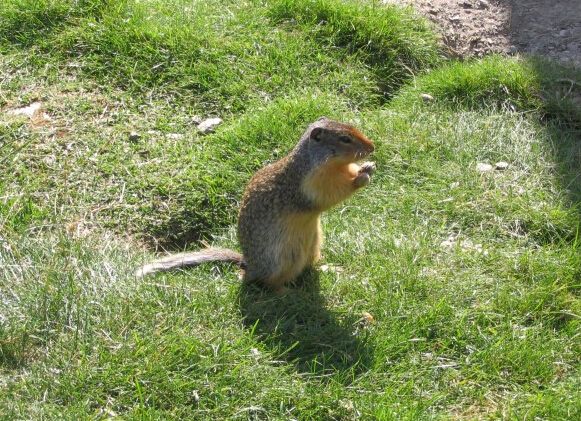(单词翻译:单击)
听力文本
This is Scientific American — 60-Second Science. I'm Steve Mirsky.
May 18th is the 37th anniversary of the massive explosion of Mount Saint Helens. But within days of the volcano erupting, the local ecosystem started to bounce back. Thanks to some unassuming little animals that spend lots of time underground.
"The pocket gophers were the ecological heroes of Mount Saint Helens."
Emory University paleontologist and geologist Anthony J. Martin.
"You normally don't hear those words put together, pocket gopher and hero. But they were...these small burrowing mammals were able to survive this massive, devastating volcanic eruption."
Just as numerous animals that live underground have survived catastrophes and predators for hundreds of millions of years. As Martin discusses in his new book The Evolution Underground: Burrows, Bunkers, and the Marvelous Subterranean World Beneath Our Feet.
"The reports I was reading about this, about how these researchers in helicopters are flying over the devastated landscape—just a few days later there were the burrow mounds. Pop pop pop. Thinking about these gophers that were below the ground. And they survived that...."

"So that to me was a golden opportunity to talk about that, as this incredible story of survival, but also renewal. That these little burrowing mammals brought back that landscape. Because their burrows served first of all as refuge for any other small animals that were there. So other small mammals and other vertebrates, such as amphibians and reptiles that lived there, they were either in their own burrows or they were in pocket gopher burrows or other small mammal burrows in the area."
"The burrowing also brought up seeds. The seeds are already buried, so that caused plants to start sprouting in the area, where it wasn't so much wind-blown seeds...then of course once other animals started coming back into the area, like elk, and they started dropping seeds through their feces and otherwise affecting the surface ecology, that then worked together to bring those ecosystems back to life. But the gophers were key in this. They really were essential for these ecosystems to be able to bounce back."
You can hear an extended interview with Martin about his book in a Science Talk podcast posted on our website. And there's a children's book just about the gophers and Mount Saint Helens called Gopher to the Rescue by Terry Jennings. Finally, for general information about gophers and their effect on landscapes, check out the nature documentary Caddyshack.
For Scientific American — 60-Second Science Science. I'm Steve Mirsky.
参考译文
这里是科学美国人——60秒科学。我是史蒂夫·米尔斯基。
5月18日是圣海伦斯火山大爆发37周年。然而在火山爆发仅几天以后,当地的生态系统就开始恢复活力。这得益于那些长期在地下生活的不起眼的小动物。
“囊鼠是圣海伦斯火山的生态英雄。”
美国埃默里大学的古生物学家和地质学家的安东尼·J·马丁说。
“通常人们不会听到囊鼠和英雄这两个词一起使用。但它们确实是英雄,这些小型穴居哺乳动物在大规模、毁灭性的火山喷发中存活了下来。”
就像许多生活在地下的动物一样,囊鼠历经亿万年的灾难和捕食者的威胁,最终幸存下来。正如马丁在他的新书《地下进化:洞穴、地堡和脚下的奇妙地下世界》中所讨论的那样。
“我看过这方面的报告,研究人员乘坐直升飞机飞越遭到重创的地区,仅仅几天以后,这个地区就出现了挖洞所留下的土堆。这些土堆突然就冒了出来。想想这些生活在地下的囊鼠。它们是幸存者。”
“对我来说,这是谈论此事的绝佳时机,因为这不仅是令人难以置信的幸存故事,也是环境重现生机的故事。这些小型穴居哺乳动物令那片土地重获生机。因为它们的洞穴首先成为了其它生活在那里的小动物的避难所。因此其它小型哺乳动物和脊椎动物——比如在那里生活的两栖动物和爬行动物——它们要么在自己的洞穴里,要么住在囊鼠的洞穴里,要么住在该地区其它小型哺乳动物的洞穴里。”
“洞穴还能培育种子。因为种子已经被埋在地里,所以该地区的植物开始发芽,而这一地区并没有太多风吹来的种子。当然,之后,一旦麋鹿等动物回到这个地区,它们就会开始通过粪便传播种子和其他方法来影响地表生态,然后共同作用,使生态系统恢复活力。不过囊鼠在环境复苏过程中起着关键作用。对可以复原的生态系统来说,囊鼠是必不可少的。”
你还可以在我们网站的《科学对话》播客中收听马丁谈论新书的完整采访。还有一本特里·詹宁斯描写囊鼠和圣海伦斯火山的儿童读物——《囊鼠救援行动》。最后,如果大家想了解囊鼠的基本信息以及其对环境的影响,可以收看自然纪录片《Caddyshack》。
谢谢大家收听科学美国人——60秒科学。我是史蒂夫·米尔斯基。
译文为可可英语翻译,未经授权请勿转载!
重点讲解
重点讲解:
1. bounce back 恢复;复原;重整旗鼓;
例句:We lost two or three early games in the World Cup, but we bounced back.
在世界杯比赛开始时我们有两三场比赛失利,但后来我们又恢复了状态。
2. put together 拼合;组合;
例句:We put together all the French books for reference.
我们集中了所有的法文书藉供参考使用。
3. bring back 恢复(惯例);使(潮流)再度流行;
例句:The House of Commons is to debate once again whether to bring back the death penalty.
下议院将再次就是否恢复死刑展开辩论。
4. serve as 用作;可当…使用;充作;
例句:Such stories serve as a spur to children's imagination.
这类故事能激发儿童的想像力。


